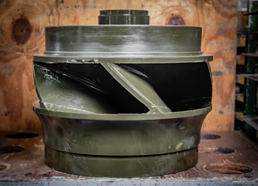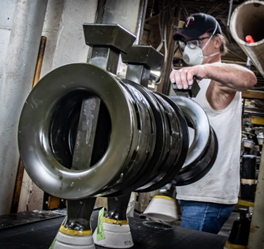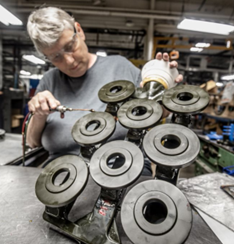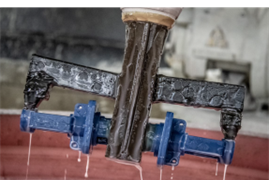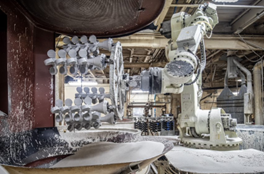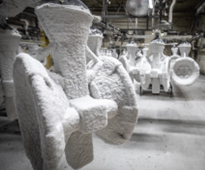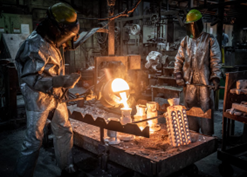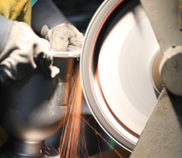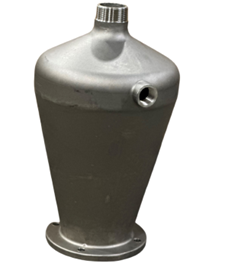Though there is a wide variety of methods for making metal parts, foundries turn to investment casting for a smoother surface finish, tighter tolerances, intricate molding, and high-volume production. When Stainless Foundry & Engineering (SF&E) opened its doors in 1946, we specialized in sand casting, primarily producing impellers for pumps. SF&E added investment casting to its service offering in 1968 in response to the increasing demand for precision parts. We’ve documented our investment casting process in a series of photos as a way to pay homage to this practice, which dates back to 3,000 B.C.
Anatomy of a Pour: Investment Casting Photo Story
What is Investment Casting?
Parts made through investment casting typically have a near-net shape, requiring minimal machining with nearly perfect precision. These characteristics make investment casting ideal for small pieces, parts with complex geometry, or designs needing to meet tight tolerances. Often, size is the determining factor on whether a part should be sand or investment cast – anything over 150 pounds will need to be sand cast due to weight and dimensions.
The investment casting process is often referred to as “lost wax” casting as opposed to sand castings, which are impression-based. Investment casting starts with a wax version of the part to be cast. It is then assembled onto a sprue and coated with a slurry sand mixture to create a hard ceramic shell. This becomes the mold. After the cycle time to properly dry the ceramic shell, which is dependent on alloy and geometry, the wax is melted away so the mold is left hollow. From there, molten metal is poured into the mold to produce the casting. Once cooled, the ceramic shell is removed through blasting, revealing the casting. Follow the photo story below as we walk you through the process, straight from the production floor.
Designing the Pattern
Just like our sanding casting process, foundry engineering at SF&E is a collaboration between our strong team of experienced foundry design engineers and the engineering team of each customer. To meet the highly diverse needs of our customers, SF&E pours more than 250 alloys, backed up by our 75+ year history of expertise. The SF&E team runs the latest and most advanced casting solidification software (Magmasoft) that aids in designing solutions for maintaining casting integrity and a high level of first-run success. Utilizing the program also analyzes metal flow to help improve initial casting quality and mitigate defects.
SF&E engineering works with die makers to design the aluminum mold used to produce the desired casting shape. Similar to sand casting molds, there are two halves used to create the entire part shape. This die block can be used to create hundreds and thousands of identical wax patterns. Now the investment casting production process is ready to begin.
Producing the Parts
First, hot wax is injected into the aluminum die block and once cooled, a wax pattern is removed and inspected. Any imperfections in the wax will also appear in the metal casting so it is important to make necessary adjustments at this stage.
Final wax patterns are assembled onto a sprue, which is a tree-like component that will hold multiple wax patterns. Now they are ready for a two-part dip process.
Wax patterns go through two different phases of being dipped into a mixture of stucco with a slurry binder to form a hard ceramic shell around the pattern. Depending on pattern size, the automated SF&E dipping rooms have a daily capacity of dipping 400 to 600 patterns. To maintain production, SF&E has two dipping rooms, both equipped with robots that have engineered dip routines, such as seen below.
Once all dipping is complete and the hardened shells are dry, the patterns go into a boiler clave, which is a pressure cooker-type vessel to melt the wax. The wax pattern melts away, leaving an empty ceramic shell that becomes the casting mold.
Lastly, prior to pouring, ceramic molds are heat conditioned in a furnace to remove residual wax. Temperature varies depending on the alloy being poured. Once the derived temperature is achieved, pouring can occur which means we introduce molten metal into the molds while they are hot to help maintain consistent temperature control.
Following the pouring and cooling of the casting, SF&E blasts off the ceramic shell, cleans the casting, and cuts off extra metal to reveal the final part.
Non-Destructive Testing (NDT) is a crucial step at SF&E for quality assurance and to meet customer specifications. NDT helps confirm quality or determine if rework is needed. It includes hardness testing, advanced welding, liquid penetrant, magnetic particle, radiographic testing, ultrasonic inspections, and visual inspection. SF&E and its approved providers are certified to the requirements of ASNT SCT-TC-1A and MIL-STD-410.
Though investment casting can come very close to the finished part requirements, the final step involves machining to cut away any excess metal, smooth out edges, buff the metal, and finalize the part.
SF&E uses high-performance alloys to produce high-quality castings of parts primarily for food & beverage, oil & gas, petrochemical, mining, power generation, aerospace, nuclear, and military industries. . We leverage new technology to suit the needs and efficiencies required of each customer, such as 3D printing when a part is too complex of a shape for a typical aluminum die. If you are interested in learning more about our investment casting capabilities, contact us at sales@stainlessfoundry.com.




